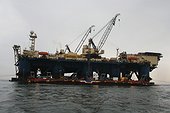First Pipelay Vessel for Nord Stream Project on its Way to the Baltic Sea
- 150 metre long Castoro Sei refurbished in the Netherlands
- Construction of the 1,224 kilometre long pipeline will start in Swedish waters
March 21, 2010 | Zug | The pipelay vessel Castoro Sei started its journey to the Baltic Sea where construction of the Nord Stream Pipeline will begin shortly. The 48-inch diameter pipeline is scheduled to start transporting natural gas to Europe from 2011. Pipe-laying activities will commence in the Swedish Exclusive Economic Zone, about 30 kilometres off the coast of the Swedish island of Gotland, at a point located 675 kilometres from the pipeline’s starting point near Vyborg, Russia and 549 kilometres from the end point at Lubmin near Greifswald, in Germany.
Upgraded for Safety and Reliability
Before starting its journey to the Baltic Sea, the Castoro Sei pipelay vessel was refurbished and upgraded in Rotterdam. Each piece of equipment was thoroughly tested in port and will be tested in operational offshore conditions in the Baltic Sea before pipe laying starts. So called sea trials are used to fine-tune the equipment and are important to familiarise the crew with on board procedures. The trials ensure that the high level of HSE (health safety and environmental) standards are met from day one. The sea trials will be attended by Nord Stream staff and independent inspectors from the certification institute DNV (Det Norske Veritas, Norway) to ensure that the project’s high quality standards are met.
The Castoro Sei is a 152 metre long semi-submersible pipelay vessel, providing a safe and reliable platform for offshore construction works. She is owned by Italian Saipem, a company with extensive offshore pipelay experience from projects worldwide including the Blue Stream pipeline in the Black Sea at a depth of over 2,000 metres and the 48-inch Dolphin pipeline in the Persian Gulf. In transit, she is towed by two anchor handling tugs. During construction, she is positioned by means of a mooring system.
Sophisticated Construction Schedule
Nord Stream has developed a pipe-laying sequence to meet environmental restrictions while allowing the construction vessels work as safely and efficiently as possible. Many factors, from ice cover to breeding seasons of birds have been taken into account. Throughout the project, two additional vessels will be used for pipe laying: The Castoro Dieci near the German shore and the Solitaire in the Gulf of Finland.






